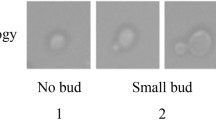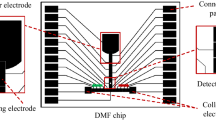Abstract
This paper proposes a novel microfluidic system based on a computer controlled digital image processing (DIP) technique and optical tweezers for automatic cell/microparticle recognition, counting and sorting in a continuous flow environment. In the proposed system, the cells/microparticles are focused electrokinetically into a narrow sample stream and are then driven through the region of interest (ROI), where they are recognized and traced in real time using a proprietary DIP system. Synchronized control signals generated by the DIP system are then used to actuate a focused IR laser beam to displace the target cells from the main sample stream into a neighboring sheath flow, which carries them to a downstream collection channel where they are automatically counted. Experimental trials show that the microchip is capable of continuously sorting and counting microparticles with diameters of 5 and 10 μm. In addition, a sample composed of yeast cells and polystyrene (PS) beads is successfully sorted and collected with a 100% of yield ratio and 91.9% of recovery ratio. The proposed system provides a simple, low-cost, high-performance solution for cell manipulation in microfluidic devices.











Similar content being viewed by others
Abbreviations
- \( \overline{V} \) :
-
particle velocity within the electric-driven flow (pixel/s)
- \( \overline{u} \) :
-
particle velocity in the x-axis direction within the electric-driven flow (pixel/s)
- \( \overline{v} \) :
-
particle velocity in the y-axis direction within the electric-driven flow (pixel/s)
- P :
-
particle position (pixel)
- t :
-
time (s)
- Δt :
-
time interval between two consequent image frame (s)
- η :
-
viscosity of the buffer liquid (N·s/m2)
- v :
-
fluid velocity of the electric-driven flow (m/s)
- r :
-
radius of particle
- BOE:
-
buffered oxide etchant
- CCD:
-
charge coupled device
- DI:
-
deionized water
- DIP:
-
digital image processing
- FACS:
-
fluorescence-activated cell sorters
- HCL:
-
hydrogen chloride
- HMI:
-
human–machine interface
- IR:
-
infrared
- LIF:
-
laser induced fluorescence
- MEMS:
-
micro-electro-mechanical-systems
- mM:
-
millimolar
- N.A.:
-
numerical aperture
- PC:
-
personal computer
- ROI:
-
region of interest
- V:
-
volt
References
A. Ashkin, J.M. Dziedzic, J.E. Bjorkholm, S. Chu, Opt. Lett., 11, 288 (1986)
B.S. Edwards, T. Oprea, E.R. Prossnitz, L.A. Sklar, Curr. Opin. Chem. Biol. 8, 392 (2004)
J. Enger, M. Goksör, K. Ramser, P. Hagberg, D. Hanstorp, Lab Chip, 4, 196 (2004)
E. Fallman, S. Schedin, J. Jass, M. Andersson, B.E. Uhlin, O. Axner, Biosens. Bioelectron. 19, 1429 (2004)
S. Fiedler, S.G. Shirley, T. Schnelle, G. Fuhr, Anal. Chem. 70, 1909 (1998)
A.Y. Fu, C. Spence, A. Scherer, F.H. Arnold, S.R. Quake, Nat. Biotechnol. 17, 1109 (1999)
D. Holmes, H. Morgan, N.G. Green, Biosens. Bioelectron. 21, 1621 (2006)
A. Ishijima, H. Kojima, T. Funatsu, M. Tokunaga, H. Higuchi, H. Tanaka, T. Yanagida, Cell 92, 161 (1998)
G.B. Lee, C.H. Lin, S.C. Chang, J. Micromechanics Microengineering 15, 447 (2005)
P.C.H. Li, D.J. Harrison, Anal. Chem. 69, 1564 (1997)
C.H. Lin, G.B. Lee, J. Micromechanics Microengineering 13, 447 (2003)
C.H. Lin, G.B. Lee, L.M. Fu, B.H. Hwey, Journal of Microelectromechanical Systems 13, 923 (2004)
C.H. Lin, G.B. Lee, Y.H. Lin, G.L. Chang, J. Micromechanics Microengineering 11, 726 (2001)
N.H. Maerz, Proc. 6th Annual Symposium ICAR, 195 (1998)
C. Mio, T. Gong, A. Terray, D.W.M. Marr, Rev. Sci. Instrum. 71, 2196 (2000)
S. Shoji, Electron. Commun. Jpn. 2, 82, 21 (1999)
F. Vajda, Mathematical Modelling and Simulation of Industrial and Economic Processes, IEE Colloquium on 1/1 (1994).
M.M. Wang, E. Tu, D.E. Raymond, J.M. Yang, H.C. Zhang, N. Hagen, B. Dees, E.M. Mercer, A.H. Forster, I. Kariv, P.J. Marchand, W.F. Butler, Nat. Biotechnol. 23, 83 (2005)
J. Wietzorrek, M. Stadler,V. Kachel, Oceans Engineering for Today’s Technology and Tomorrow’s Preservation 1, I/688 (1994).
H.-S. Wu, J. Barba, J. Gil, IEEE Trans. Biomed. Eng. 45, 400 (1998)
C.Q. Yi, C.W. Li, S.L. Ji, M.S. Yang, Anal. Chim. Acta 560, 1 (2006)
Acknowledgment
Financial supports from the National Science Council of Taiwan are acknowledged. (NSC 95-2314-B-110-002-MY3).
Author information
Authors and Affiliations
Corresponding author
Rights and permissions
About this article
Cite this article
Lin, CC., Chen, A. & Lin, CH. Microfluidic cell counter/sorter utilizing multiple particle tracing technique and optically switching approach. Biomed Microdevices 10, 55–63 (2008). https://doi.org/10.1007/s10544-007-9109-8
Published:
Issue Date:
DOI: https://doi.org/10.1007/s10544-007-9109-8




